6 Tips for Accelerating Your Supplier Search


Key Takeaways:
In this fast-changing world, finding the right suppliers quickly can make or break your procurement strategy.
Yet, the search process often drags on due to outdated methods, endless vetting, and slow approvals.
The good news?
With the right approach, you can cut through the complexity and speed things up without sacrificing quality.
In this article, we’ll explore six practical strategies to help you accelerate supplier search and make sourcing more efficient.
The fastest way to find the right supplier is to know exactly what you’re looking for.
Without clear criteria, procurement teams waste time evaluating unqualified suppliers or going back and forth on basic requirements, ultimately prolonging the search process.
Setting key factors—such as production capacity, location, lead time, and certifications—helps eliminate irrelevant options upfront, ensuring focus on only the best-fit suppliers.
Among these, supplier certifications for quality, ESG practices, information security, or industry-specific standards are particularly useful for filtering search results.
To illustrate, here are some key supplier certifications:
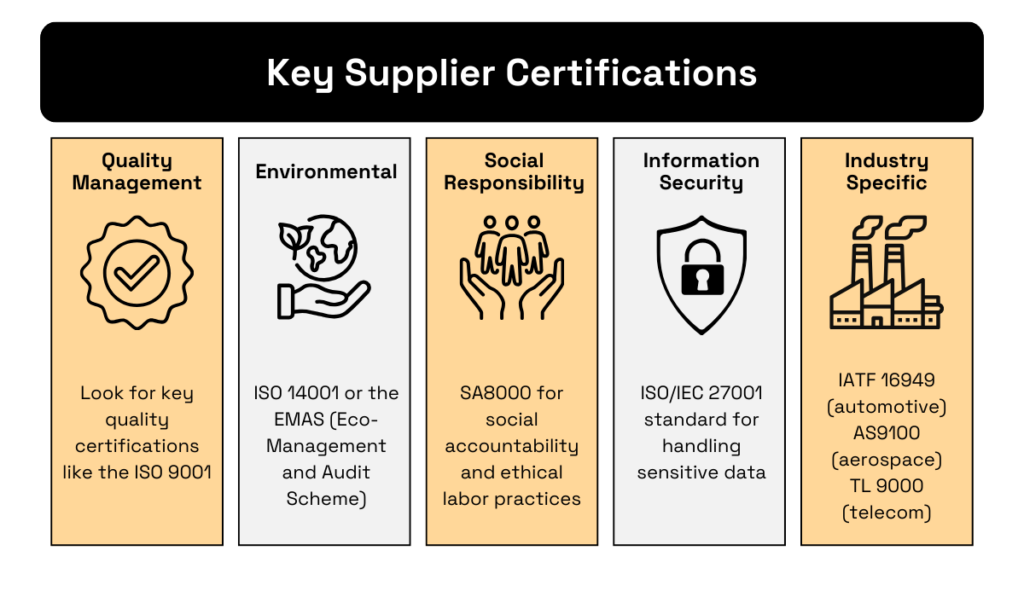
Source: Veridion
Since certifications are typically provided by independent third parties, such as ISO or IATF, they can serve as primary filters for creating an initial list of eligible suppliers.
The same approach applies to other key factors, such as:
Defining these criteria upfront helps leverage supplier directories and sourcing platforms to quickly narrow down options and focus on the best-fit suppliers.
For example, if you’re sourcing steel with a vague goal like “find quality steel at the best price,” you’ll face too many options and potential analysis paralysis.
But if the goal is more specific—like sourcing from green steel producers—applying this criterion from the start will refine your global search, cutting time spent on irrelevant suppliers.

Source: Veridion
A crucial precondition for setting clear supplier criteria is close collaboration with key stakeholders across your organization, such as legal, compliance, and production teams.
This ensures the criteria reflect all necessary specifications and aspects of the future supplier relationship.
It’s also important to balance strict requirements with market realities.
Setting too many filters can limit viable options, particularly for products, components, or materials with fewer suppliers.
Therefore, prioritize must-have criteria while maintaining some flexibility on secondary, nice-to-have factors.
Overall, having clear criteria upfront accelerates and simplifies the initial supplier search, whether through directories, sourcing platforms, or both.
Using supplier directories and marketplaces accelerates the search process by providing a curated database of pre-vetted suppliers.
These platforms allow your team to filter results based on key criteria like industry, location, and certifications, streamlining the search for eligible suppliers.
Many platforms offer free search options, with or without registration, where your team can explore potential suppliers and contact them for information or quotes.
A well-known example is Thomasnet, which focuses on North American suppliers and boasts over 500,000 companies on its platform.
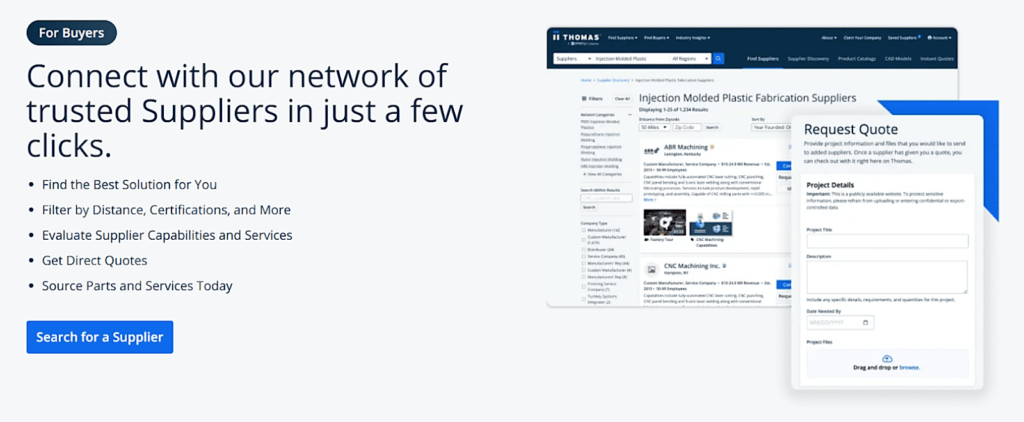
Source: Thomasnet
As such, Thomasnet is ideal for businesses seeking suppliers in the US and Canada.
However, it also highlights two common downsides found in most supplier directories and marketplaces.
First, when it comes to “trusted” or “pre-vetted” suppliers, this status often relies on self-reported data with little to no external verification.
As a result, additional vetting is still necessary, regardless of the supplier’s directory status.
Second, the scope of your search is limited—in Thomasnet’s case, to North America.
Similarly, platforms like Alibaba are predominantly focused on Chinese suppliers, which may restrict your global sourcing options.
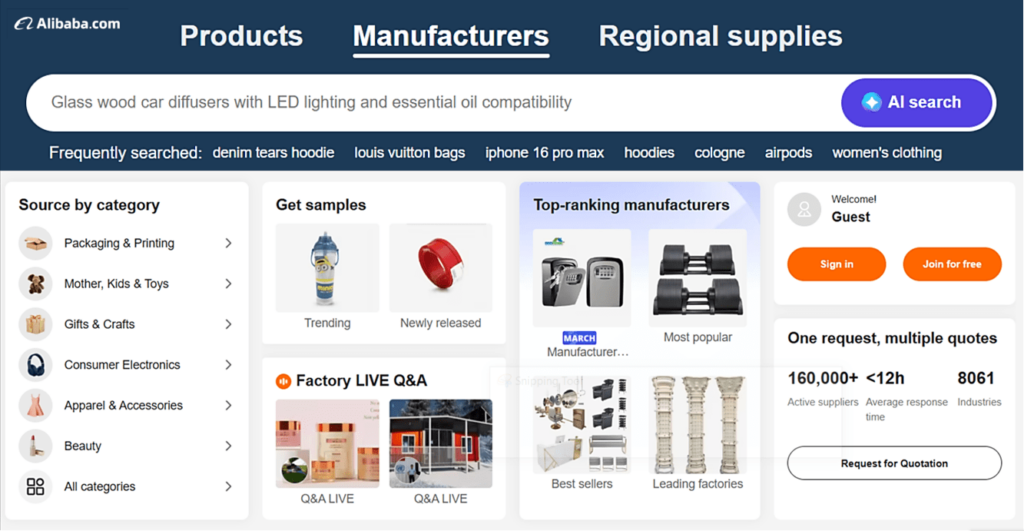
Source: Alibaba
As for Alibaba’s vetting practices, they can also vary significantly, making due diligence essential.
Verifying supplier credentials, requesting product samples, and securing trade assurances can help mitigate risks.
Despite these limitations, curated directories and marketplaces remain valuable tools for accelerating supplier searches.
They offer structured search filters, verified contact details, and access to a large pool of suppliers.
To use them effectively:
In such cases, AI-driven procurement technology can provide independent verification of supplier info and real-time insights or serve as a standalone supplier search method.
Compared to directories and marketplaces, AI-driven sourcing platforms offer a global, unrestricted view of suppliers while enabling data verification and risk assessment.
Instead of providing limited, self-reported data, AI-powered technology analyzes vast datasets in real time to identify suppliers that best match a company’s needs.
This significantly reduces the time spent on manual searches and supplier vetting.
How?
AI-driven machine-learning (ML) algorithms or “bots” continuously scan the internet, collecting and refining supplier data.
These bots improve over time, ensuring regularly updated and highly accurate insights.
For instance, our AI-powered data engine, Veridion, ensures all data is updated weekly, offering unparalleled coverage and precision.
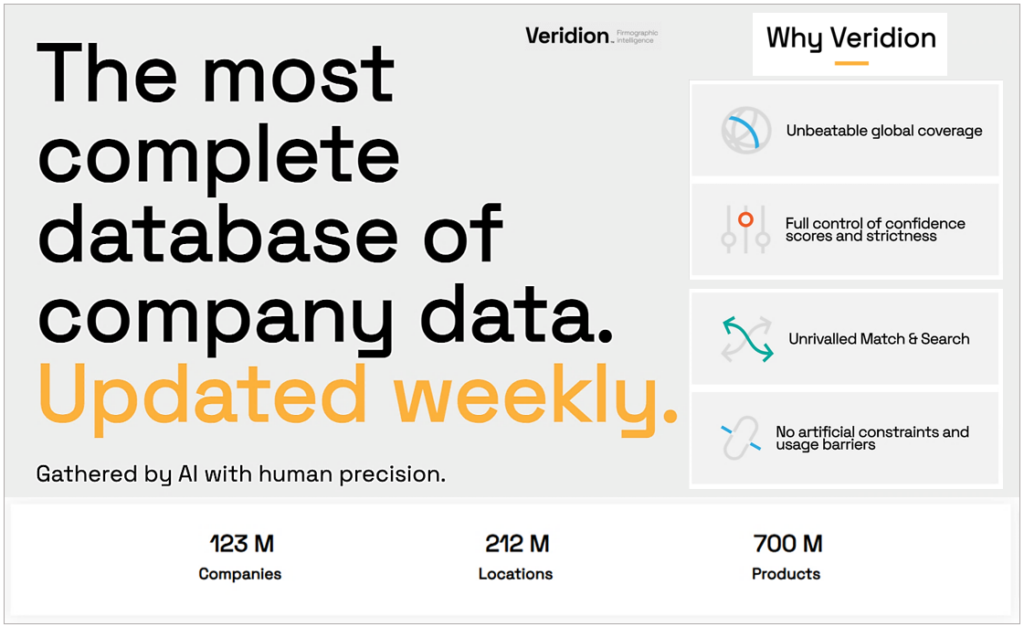
Source: Veridion
With Veridion, supplier discovery is fast and intuitive.
Your team simply enters search criteria in natural, descriptive language, and the AI-powered engine delivers results within seconds.
This search can be initiated within another procurement software solution integrated with Veridion’s API, or via Veridion’s online search engine, Scout.
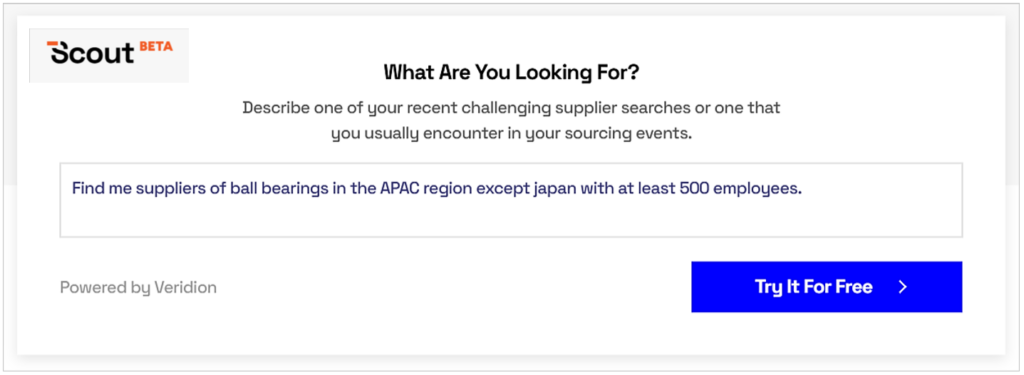
Source: Veridion
Once the initial shortlist is generated, your team can refine the results by adding more parameters.
With confidence scores assigned to each data point, verifying accuracy becomes effortless.
All this streamlines supplier evaluation and risk management, making the process faster and more data-driven.
For example, your team can use the platform’s market intelligence to benchmark potential suppliers against their counterparts.
Likewise, they can filter suppliers according to their environmental, social, and governance (ESG) factors.
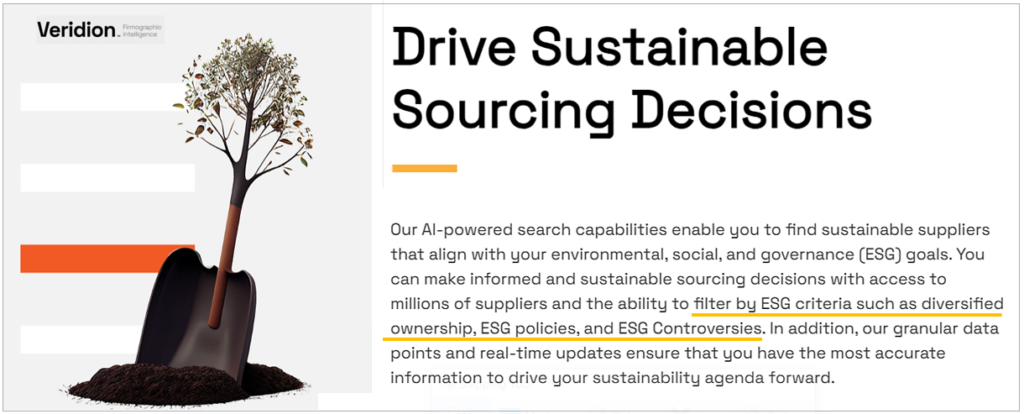
Source: Veridion
By factoring in ESG commitments and actions, your team can ensure that sourcing aligns with sustainability and ethical standards.
Clearly, AI-driven procurement technology goes beyond directories and marketplaces.
It automates supplier discovery, analyzes massive datasets, and recommends the best-fit suppliers based on historical performance and market trends.
Moreover, AI-powered tools can leverage machine learning and predictive analytics to identify high-potential suppliers your team may not have considered, further accelerating the search process.
Traditional approval processes can be a major bottleneck in supplier selection.
This is especially the case when multiple departments—such as procurement, finance, compliance, and legal—need to sign off.
Sequential approvals, where each stakeholder reviews documents one after another, often create unnecessary delays, slowing down sourcing decisions and increasing time-to-contract.
Implementing a simultaneous approval workflow can significantly accelerate this process.
By allowing relevant teams to review and approve supplier selections in parallel, businesses can reduce waiting times, improve efficiency, and avoid costly project delays.
For example, in the process flowchart below, each “Accepted?” and “Approved?” step may involve multiple stakeholders at different approval levels.

Source: Informatica
If these approvals are done sequentially, the process can quickly become inefficient, leading to stalled negotiations and missed opportunities.
A simultaneous approval workflow solves this by allowing multiple stakeholders to review supplier applications in parallel, rather than waiting for each other’s approval.
This reduces bottlenecks and accelerates decision-making without compromising compliance or due diligence.
Most modern procurement platforms allow organizations to configure parallel approval workflows, automate notifications, and track approvals in real time.
For example, SAP Ariba offers the option to select either a “Serial” or “Parallel” approval workflow.
In parallel mode, SAP Ariba assigns approval tasks to multiple stakeholders simultaneously, as shown below.

Source: SAP
Implementing parallel approval workflows can significantly speed up supplier onboarding and contract approvals while maintaining compliance and risk management.
For example, Mondelēz International introduced centralized data management and a supplier portal while also enabling multiple stakeholders to approve supplier information simultaneously.
This reduced supplier onboarding time by 86%.
Additionally, automation features in modern procurement platforms ensure that approvers receive real-time notifications and reminders, minimizing manual follow-ups and delays.
Overall, shifting from sequential to simultaneous approvals can eliminate process bottlenecks, accelerate decision-making, and improve overall procurement efficiency, without compromising due diligence.
Procurement teams sometimes negotiate with one supplier at a time to simplify discussions, avoid confusion, and maintain focus.
While this may work in some cases, sequential negotiations can be inefficient.
Why?
Because if one supplier backs out or fails to meet expectations, the team must restart the process, leading to delays and lost opportunities.
That’s why many procurement projects involve negotiations with multiple suppliers simultaneously.
This can be achieved through structured processes that combine competitive dynamics with strategic collaboration, often initiated using RFx platforms like the one below.
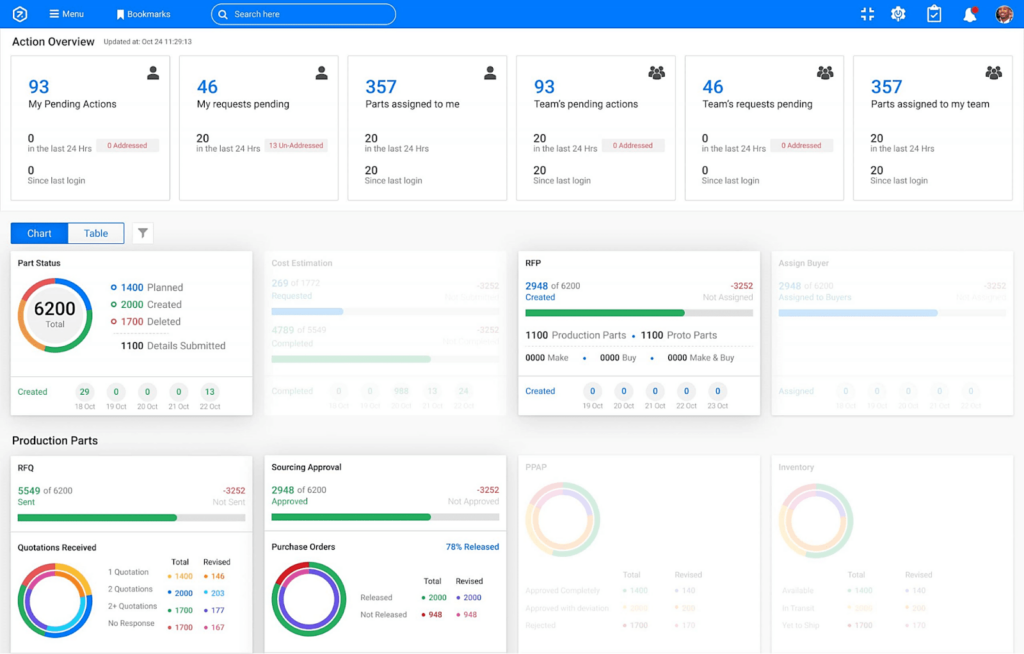
Source: Zumen
RFx platforms offer a digitized, structured approach for inviting multiple suppliers to submit bids and participate in negotiations.
Depending on the type of RFx process and its goals, these platforms can foster a competitive environment where each supplier understands they are competing for the same contract.
This creates a sense of urgency and encourages suppliers to offer more competitive pricing.
Additionally, RFx tools streamline negotiations by centralizing communication, making it easier to manage multiple proposals and resolve any issues with suppliers in real time.
RFx platforms also offer features like automated notifications, real-time updates, and bid comparison tools, allowing procurement teams to evaluate offers quickly and objectively.
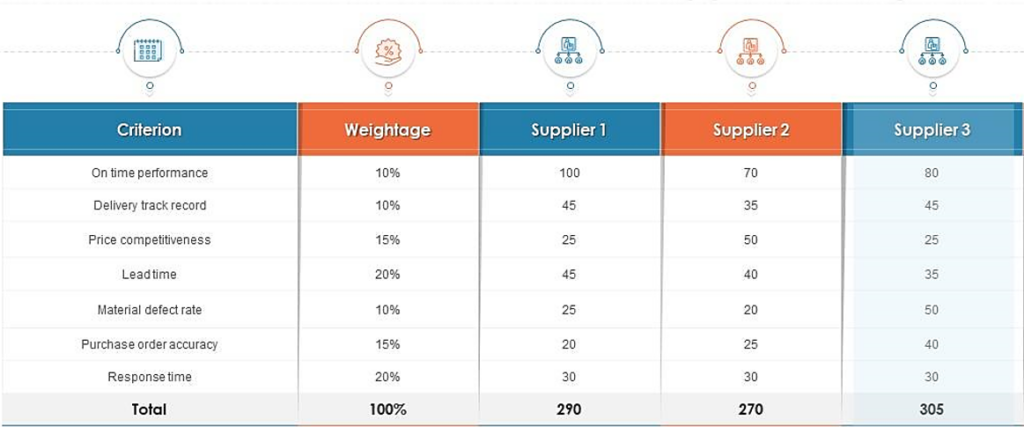
Source: Slide Team
All these features not only accelerate supplier search, but also streamline the negotiation phase.
To maximize the benefits of parallel negotiations:
Additionally, set up clear communication channels and automated notifications to keep all parties informed in real time.
Finally, use comparison tools like supplier scorecards to objectively assess proposals and make data-driven decisions.
In summary, negotiating with multiple suppliers simultaneously saves time and can lead to better outcomes.
Sometimes, the ideal supplier you’re looking for is already within reach, hidden inside your supplier network.
In other words, asking your existing suppliers for recommendations can save time on market research and streamline the vetting process, leading to faster onboarding.
This approach works because established suppliers have a vested interest in maintaining a strong partnership with your company, making them unlikely to recommend subpar vendors.
Beyond efficiency, supplier networks can also drive innovation.
For example, when Organic Valley, an organic food co-op, needed innovative packaging for its Brussels sprouts, it turned to its suppliers for recommendations, leading them to Dr. Marston.
As Organic Valley’s produce program manager, Annake Ramsey, explains:
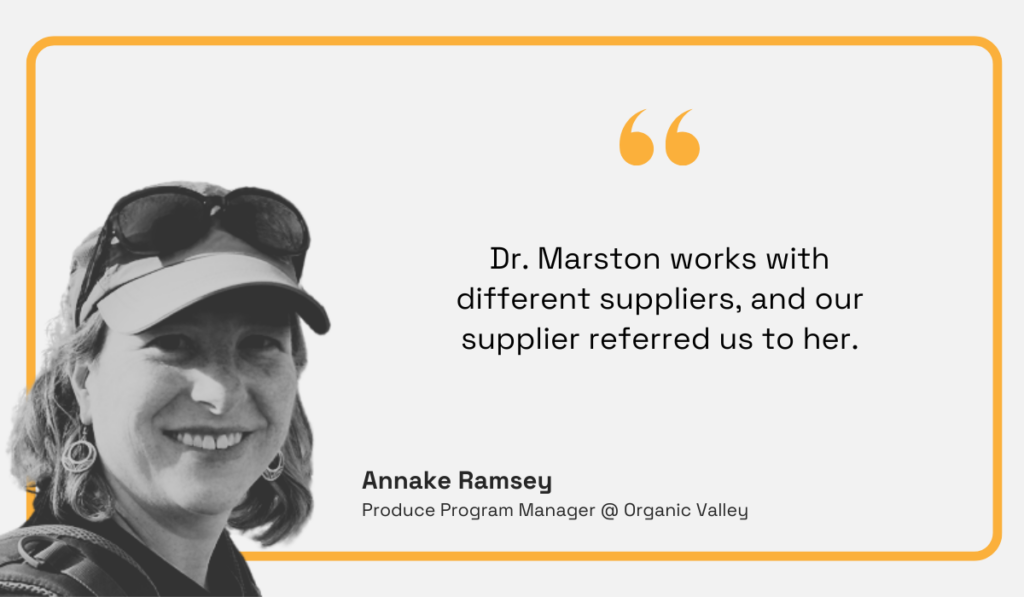
Illustration: Veridion / Quote: Produce Processing
This recommendation led to the development of breathable packaging that maximized shelf life for both Brussels sprouts’ bulk bags and retail pouches.
Beyond packaging solutions, supplier networks can help businesses find specialized manufacturers, source sustainable materials, or identify vendors with niche expertise.
Additionally, supplier recommendations can reduce risk, as referrals often come from partners who have already vetted a vendor’s reliability and quality.
However, not all referrals are equally valuable.
It’s important to keep in mind that some may be influenced by self-interest or personal connections, rather than objective criteria.
That’s why it’s smart to combine referrals with RFPs and other formal evaluations, including risk assessments.
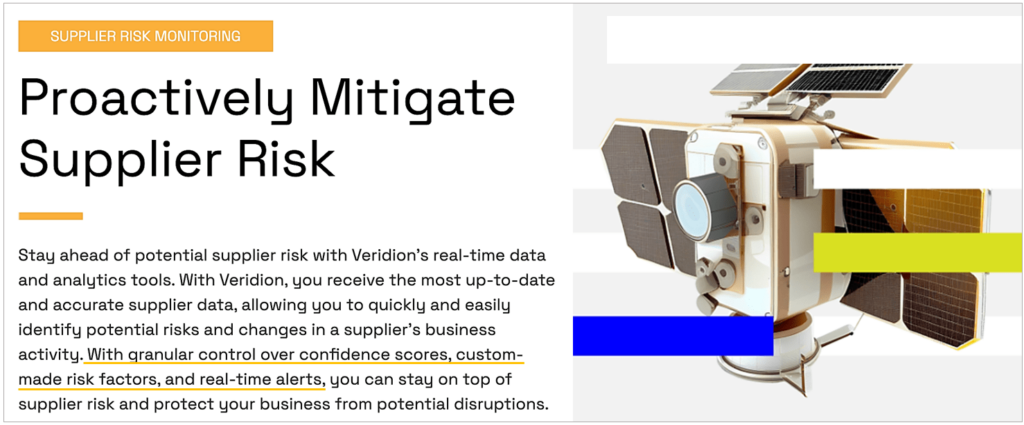
Source: Veridion
By blending referrals with rigorous evaluation and strategic sourcing practices, your organization can mitigate risks while fully leveraging its supplier network.
Moreover, AI-powered tools can sometimes uncover internal referrals, showing that you may not need a new supplier at all.
If your supplier profiles are outdated, you might overlook an existing partner who has already expanded their capabilities to meet your needs.
That’s why maintaining up-to-date supplier records is crucial, and supplier data platforms can automate this process.
Overall, strategically using supplier referrals—while validating recommendations with data-driven insights—can shorten time-to-contract, mitigate risks, and help secure high-quality partners.
From defining clear search criteria to tapping into your supplier network, we’ve explored various strategies and tools to accelerate the supplier search.
Whether through supplier directories, AI-driven sourcing platforms, or peer recommendations, procurement teams can mix and match these approaches for a more efficient process.
Likewise, leveraging simultaneous approvals and parallel negotiations can further streamline sourcing and decision-making.
Now’s the time to review your policies, identify areas for improvement, and apply these strategies to optimize your supplier selection.